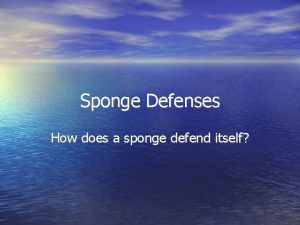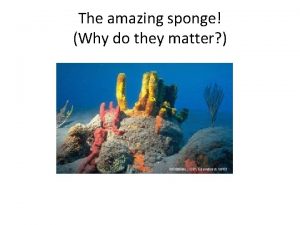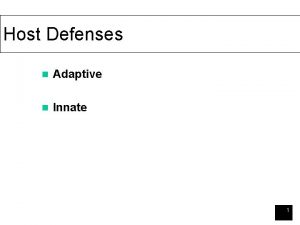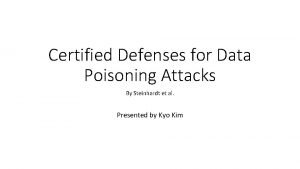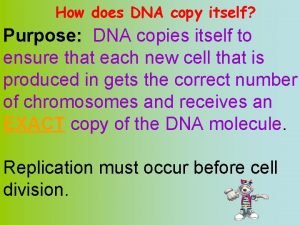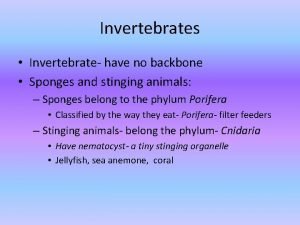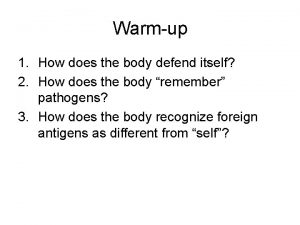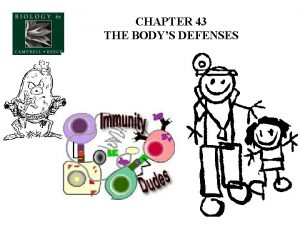Sponge Defenses How does a sponge defend itself



















- Slides: 19

Sponge Defenses How does a sponge defend itself?

Chemical Defense • Many sponges have chemical defense mechanisms that help protect them against certain bacteria; they produce toxins or unpleasant tastes and odors that ward off predators or prevent coral overgrowth that could threaten the sponge's osculum or other systems

What are secondary metabolites? • Secondary metabolites- are organic compounds that are not directly involved in the normal growth, development or reproduction of organisms, these can be wastes from metabolism or chemicals produced for defense, competition or that aid in reproductive success

What are some secondary metabolites? • Alkaloids- naturally occurring amine in plants • • • and animals Terpenoids- lipids, largest group of natural products made by many varied organisms Glycosides- heavily modified sugar molecules Other compounds-Phenols, phenazines, polyketides, fatty acid synthase products, non ribosomal peptides

Why do sponges use secondary metabolites for defense? • Sessile- animals that are not able to move about Ex. Sponge, hydra • A sponge is attached to a solid surface and is unable to flee when faced with a predator Azure vase sponge

What do sponges do when threatened? • When threatened sponges can release those stored secondary metabolites that have cytotoxic, antibiotic and feeding deterrent properties • These chemicals prevent settlement of fouling organisms on the sponge surface and restrict competition for space with neighbors

Spatial Competition • Space on which to live is often the most important limiting resource in marine hard -substrate environments. Maintenance of a given level of diversity in these environments has been attributed to the interacting roles of competition, predation, and disturbance.

Spatial Competition • Evidence shows that sponge metabolites may act as allomones by preventing overgrowth of some sponge species, and as both allomones and kairomones by enhancing overgrowth of others.

What do sponges do when threatened? • They can repel potential predators • They control bacterial growth within their bodies • Sponges can actively defend by upon injury, they can convert less active precursor molecules to more active defense chemicals to repel predators or prevent infection of the area

Aplysina aerophoba • This sponge from the • Mediterranean upon injury degrades its defensive chemicals and manufactures compounds, aeroplysinin-1 and a dienone, with strong antibiotic properties prevents infection of injured cells

Feeding deterrent • In order for a sponge to prevent predation it • • must release chemicals that make another organism not want to feed on it Researchers have separated some of these materials and added the to fish food to see the reaction of predatory fish By isolating and identifying these compounds researchers have been able to utilize the properties of the isolated compounds

Fire Sponge • Tedania ignis, also known as fire sponge, is a species that is readily found in Bermuda on any type of substrate. T. ignis is an interesting sponge because it contains toxins as a defense mechanism to deter predators, which can be shown as an adaptation due to the increasing amount of predators.

Fire Sponge • The main defenses of fire sponge involve chemical deterrence, contain spongin spicules, as well as have refractory collagen, which allows the sponge to be rubbery and discourage predators from eating them.

Caribbean Reef Sponge • Studies have determined that Caribbean reef sponges of the genus Agelas are chemically defended from fish predation by bromated pyrrole alkaloids.

Defense Mechanism The defense mechanism of a fire sponge is a toxin that is expelled through the spicules, which pierces the predator, causing a severe rash when handled by humans, or will cause the predator discomfort. Caribbean reef fish do not feed on Tedania ignis due to its toxic chemical it produce. However there are some animals that have defense mechanisms against this in which they are able to digest the sponge toxic material for example some starfish. T. ignis uses chemical deterrence to protect themselves against overgrowth, or the killing of other species larvae; therefore allowing the fire sponge to thrive.

A Starfish wins the Arms Race! • Starfish in Bocas del Toro Panama and Belize have evolved a mechanism to breakdown the Fire sponge toxin and consume the entire sponge. amount of predators.

Questions • What is the difference between a primary metabolite and a secondary metabolite? • What is the term for non motile? Name other non motile organisms. • How do sponges defend themselves against predatory fish? 2 ways

• What is one possible • way that Spongebob can defend himself from predators? What if Spongebob was to get invaded by bacteria, how would he defend himself?

How successful do you think this stern warning would be against a predator?
 How do sponges defend themselves
How do sponges defend themselves Amazing sponge
Amazing sponge Rijandael
Rijandael Spongebob's aunt is famous around town
Spongebob's aunt is famous around town Bikini bottom genetics worksheet
Bikini bottom genetics worksheet What ugly things is atticus worried about
What ugly things is atticus worried about Primitive defense mechanisms
Primitive defense mechanisms Chapter 12 the lymphatic system and body defenses
Chapter 12 the lymphatic system and body defenses Host defenses
Host defenses On adaptive attacks to adversarial example defenses
On adaptive attacks to adversarial example defenses Certified defenses for data poisoning attacks
Certified defenses for data poisoning attacks Chapter 12 the lymphatic system and body defenses
Chapter 12 the lymphatic system and body defenses Nicolas papernot
Nicolas papernot Chapter 12 the lymphatic system and body defenses
Chapter 12 the lymphatic system and body defenses Good delivery does not call attention to
Good delivery does not call attention to Does malicious code manifest itself
Does malicious code manifest itself How does the amur leopard protect itself
How does the amur leopard protect itself How does dna copy itself
How does dna copy itself Does a sponge have a backbone
Does a sponge have a backbone How long did the texans defend the alamo
How long did the texans defend the alamo
